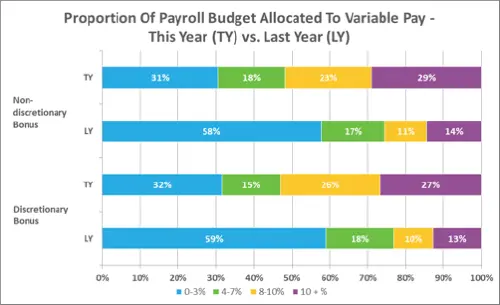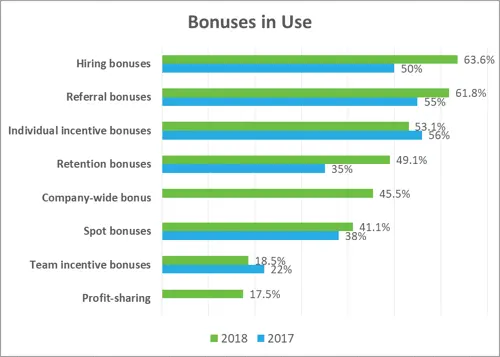What is Pay-for-Performance Compensation?

The term “pay-for-performance compensation” refers to performance-based pay programs where an employee is incentivized and rewarded for achieving goals or objectives. Pay-for-performance plans are extremely popular – according to our recent Pay Practices and Compensation Strategy survey, 75% of organizations currently leverage pay-for-performance compensation as part of their overall compensation plan.

Pay-for-performance compensation can come in many varieties depending on your organization’s budget, compensation philosophy, and organizational goals. When designing a pay-for-performance plan, you’ll want to consider the outcomes your organization is looking to achieve, the frequency with which you’ll reward employees, and the total increase you’ll be budgeting to fund these programs.
In this article, the following questions will be answered:
- What is pay-for-performance compensation?
- What are the objectives for pay for performance?
- Why is pay for performance good?
- What should be in a pay for performance plan?
How Does Pay-for-Performance Compensation Work?
There are two general categories of pay-for-performance compensation: merit pay increases and variable pay programs. As you look to implement a pay-for-performance program in your organization, you can use either of these two types of pay-for-performance plans – or both – to incentivize employee performance and drive your desired outcomes.
Merit Pay Increases
A merit pay increase refers to an increase to an employee’s base pay due to high performance. These raises are typically delivered an annual basis, and are budgeted for as part of the annual salary increase budgeting process. Merit pay increases are the most commonly used pay-for-performance model for recognition of employee performance, as they deferentially reward top performers for their contributions with a bump to their base salary for the following year.
However, according to Chris Fusco, the Senior Vice President of Compensation at Salary.com, the external market is progressing in pay faster than merit pay increases alone can match. This makes top performers in your organization a flight risk, because they could potentially walk out the door just to take a job that offers more competitive pay.
Addressing Market Movement with Pay-for-Performance Programs
In this competitive environment, many organizations are turning to variable pay programs to keep top recruits’ and top performers’ pay competitive with the market. Whereas salary increase budgets have remained flat at 3% for the last several years, data from Salary.com’s Pay Practices and Compensation Strategy Survey shows that many firms are adding budget to their variable pay programs. According to our survey, the percentage of organizations committing at least 10% of their payroll budget towards non-discretionary bonuses and discretionary bonuses has more than doubled since 2017, while the percentage of organizations committing less than 3% of their total payroll budget to such programs has diminished over time.

Clearly, the organizations that offer variable pay programs have seen performance boosts because of these incentives, and are now beginning to allocate a larger proportion of their budget to them each year.
Variable Pay Programs
Variable pay programs encompass a variety of discretionary and non-discretionary bonuses that can vary according to the payout period, the employees who are eligible, and the metrics that employees are measured against. Unlike merit pay increases, variable pay programs are increasingly administered not just annually but multiple times a year (e.g., once a quarter) and a mix of different variable pay programs are often used in combination to achieve the desired results.
Discretionary bonuses are awarded on an ad-hoc basis to employees who demonstrate exceptional performance, often without consideration of pre-defined goals and objectives. Some common discretionary bonus types are:
-
Spot bonuses – Reward employees “on the spot” for achievements that deserve special
recognition.
-
Project bonuses – Reward employees for completion or superior completion of a specific
project.
- Retention bonuses – Typically awarded to long-tenured employees, or employees in hot jobs, to decrease their flight risk.
Nondiscretionary bonuses are awarded when employees, teams, or the entire organization meets specific, pre-defined goals and objectives. Based on the duration of the assessment period (the amount of time over which performance is measured), they are considered either short-term incentives (STI) or long-term incentives (LTI). Some common nondiscretionary bonus types include:
-
Company-wide bonuses – these focus around specific improvement goals for the
organization, and reward employees based on how much improvement is made on these goals within a certain
period of time.
-
Team-incentive bonuses – these focus around specific improvement goals for one team
(e.g., marketing or sales) and are rewarded based on performance for that team.
- Individual incentive bonuses – these plans are often based on predetermined, measurable business objectives (MBOs) that are evaluated periodically (e.g., each quarter) based on one person’s performance
Of all the variable performance bonus types, individual incentive pay plans were the most popular, used by 53% of participants in our survey. An organization’s pay-for-performance compensation strategy will likely include a combination of merit increases and short-term incentive plans.

Hiring bonuses and referral bonuses, while not tied pay for performance, were the most widely used form of bonus compensation in our survey. These bonuses are designed to attract and hire strong candidates, and are especially popular in today’s tight recruiting market.
A Proven Recipe to Boost Employee Engagement – Compensation and Performance
Our research also shows that organizations with a formal pay-for-performance philosophy are more than twice as likely to have above average or excellent employee engagement. That means that tying compensation to performance can be a strategic human resource management strategy.
Pay-for-performance compensation models improve employee engagement and retention by clearly tying employee or company achievement of performance goals to tangible financial rewards. These programs also enable employees to see a clear connection between the work they do every day and the success of the company as a whole.
Since they are frequently awarded, they can also facilitate more regular conversations about individual and company performance, allowing managers to provide critical feedback outside the annual review process.
Pay-for-performance compensation plans are not just necessary to keep up with today’s talent market. Pay-for-performance plans can help employees grow professionally due to their desire to be rewarded. Frequent rewards can also lead to increased employee retention, as the money motivation helps keep staff at your business long-term. And of course, increased retention will lead to greater productivity and lower turnover costs.
Insights You Need to Get It Right







